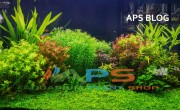Signs That Depict Low Nutrients in Aquarium Plants
Signs That Depict Low Nutrients in Aquarium Plants
Have you planted
a perfect aquarium with all the essential items for aquarium plants and
they are still dying? Are you worried about your plant’s health and want to
ensure its sustainable growth and development? If the answer is yes then this
article is right there to enlighten you. In this article, we will explore the signs
of nutrient deficiency in aquarium plants and what to do next to
cure them before they die. So, let’s get started.
Symptoms
of Nutrients Deficiency:
Though every
plant species is different and there can be unique symptoms as well. However,
the most common symptoms of nutrient deficiency in aquarium plants
are written below.
·
Old leaves turn yellow
and translucent: It is a classic sign of
nitrogen deficiency. This happens when there is inhibition of chloroplast and
chlorophyll synthesis. Nitrogen is classified as a macronutrient and is vital for
plants’ health. When there is nitrogen deficiency; the plants turn yellow at
their leaf tip.
·
Paleness or yellowing on
new leaves: When new leaves turn pale or
yellow; it is an indication of iron deficiency. Iron-specific supplements are
also available in the market that can readily cure this deficiency.
·
Development of
distinctive pinholes: When the leaves of plants
develop brown or yellow-colored distinctive pinholes; it indicates the
deficiency of potassium. Potassium is imperative for plant growth as it
contributes to enzyme activation within the plant.
·
Leaves turn yellow with
soggy brown patches: When the older leaves turn
yellow with soggy brown patches; it indicates a phosphate deficiency. Phosphate
is consumed in large quantities by the plants to fulfill their micronutrient
requirement. With soggy brown patches; there can also be another associated
symptom, i.e., the green algae spots.
·
Old leaves turn lighter
in color: When the old leaves turn lighter in
color with dark veins; it indicates a magnesium deficiency.
·
New leaves grow in a
twisted fashion: When new leaves grow in a
twisted fashion; it denotes a calcium deficiency. It also indicates an issue
related to water hardness.
What’s
Next?
To fix the
nutrient deficiency and treat your plants appropriately; identify the nutrient
deficiency in the first place. When you are done the next step is to look
for good quality fertilizer or specific supplements to nourish your plants. The
dosage is also important to consider as per the plant’s need. Most of the plant
deficiencies can be resolved by buying
an all-in-one fertilizer that has all the essential nutrients for most of the aquarium
plants.
Final Thoughts:
When considering
deficiency symptoms in your aquarium plants; be aware of the optical
factors. The optical factors can give you an illusion of nutrient deficiency
in your plants even without any reason. For instance, the color of the light
source might show pale-colored leaves of your aquarium plants and you
can infer that it’s a calcium deficiency. So, it is important to pay
considerable heed to other factors such as the angle of incidence to be sure of
what exactly is the cause behind a deficiency.
Comments
Related Blogs
How Aquarium Plant Helps your Aquarium Tank?
Aquarium plants are highly beneficial for your aquarium tank especially for the enhancement of water quality. By producing oxygen during the daylight and minimizing algae growth; the aquarium plants are a great source of encouraging a stress-free env Read More
- 3
- 0 Comments
Comparison of Aquarium Tank with or Without Live Aquarium Plants
The live aquarium plants bring a lot of benefits to the aquarium tank. Besides being good decorative items; they are good for the fish’s healthy functioning. However, they are not compulsory for the aquarium tank and fish, and the tank can still lo Read More
- 4
- 0 Comments
Best Fertilizer for Your Aquarium Plants
The aquarium plants need fertilizer for their growth as it provides them with essential nutrients. However, if you have a lot of fish or messy fish in the tank; then, plants can get this source from the fish’s poop. Anyhow, fertilizer is good for p Read More
- 6
- 0 Comments




